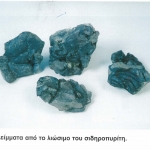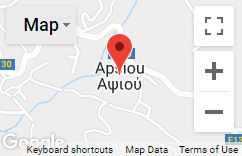Μεταλλεία
The geographical location of the village, its “origin” in the Troodos Mountain, makes it a “source” of minerals and rocks. There were iron-pyrites and copper-pyrites mines in the village as well as a pit producing tiles and bricks.
The mine for copper-pyrites started operating at the beginning of the 20th century, while the copper-pyrites mine around 1930. They both stopped working in the middle of the 20th century, in 1953. The existence of these two mines is now indicated by some crawlways.
The first caretaker of the mine, according to Charidemos Georgiou, was a refugee from Asia Minor named Michalis Gavrielides.
The workers at the mine were responsible for the extraction and the transportation of the minerals to the port of Limassol. That is why the passenger cars that used to transfer workers were also turned into “trucks” by removing the back seats.
What is more, there was a mineral analysis laboratory in Apsiou at the house of Lampros Antoniades. There was only one chemist, named Yiagos Kokkinos. Even today, the specific house is known as the villages “lab”.
It is worth mentioning that in “Kato Apsiou” there was a factory of metal processing since the 19th century. Remains of molten metal are found in the area.
Source:
Charidemos Georgiou. “Mines and pits”, in the magazine Apsiou-1995


Pits
Rocks were excavated from the pit, used to produce tiles and bricks.
The first pit was situated in the “Koutsagohoma” area, and that is why the mine workers were also called “koutsagaes”. They used to make pots, large jars and small plates using mud from the pit. These plates were used to construct church roofs, such as the roofs of Panagia Chrysogalousa in Pano Apsiou.
Two more pits functioned in Apsiou in the areas of “Marousa” and “Kaou”. Excavated mud was from now on processed in the “Ceramic Workshop of Limassol”. The material excavated from the “Koutsagohoma” pit was transferred to the workshop after an arduous process, since there was no roadway connecting the pit with the village. Thus, the mineworkers had to place the mud on “aerial wagons” and lead them to the road.
Finally, it must be noted that working at the pits was one of the main professions for the inhabitants of Apsiou since 1940 until 1965. Charidemos Georgiou mentions that “the whole village worked with mud”. What is more, he mentions that each family had a small piece of land in one of the pits of the village.
Source:
Charidemos Georgiou. “Mines and pits”, in the magazine Apsiou-1995








